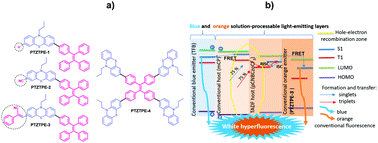White hyperelectrofluorescence from solution-processable OLEDs based on phenothiazine substituted tetraphenylethylene derivatives†
Abstract
Mechanochromic emitters with an appropriate combination of properties for white hyperfluorescent solution-processable organic light emitting diodes (OLEDs) were developed involving phenothiazine, tetraphenylethylene, and electron withdrawing (cyano (–CN)) or phenyl acrylonitrile (–CHC(CN)Ph) groups. Among the four studied compounds, the best performance in white hyperfluorescent OLEDs was shown by one compound (named PTZTPE-3) due to its orange emission with a high photoluminescence quantum yield of 66% observed for toluene solution and of 39% for doped films, low-dispersity hole-transporting properties, appropriate ionization potential (5.5 eV) and electron affinity (3.24 eV). The perfect combination of these characteristics is required for efficient white hyperfluorescence. Mechanoluminescence properties with hypsochromically shifted emission under external stimuli were additionally detected and studied in detail for the developed PTZTPE compounds discovering their multifunctionality for either sensing, imaging, security, memory or other proposes. Using PTZTPE compounds hyperfluorescence systems were developed and utilized in simple processed white organic light-emitting diodes involving a conventional host, a host with thermally activated delayed fluorescence (TADF) properties and singlet emitters. Due to Förster resonance energy transfer from co-hosts to blue and orange emitters, hyperfluorescence based white OLEDs were developed. They were characterized by high quality of white electroluminescence with a color rendering index of 67 and CIE1931 color coordinates of (0.28, 0.38), in the best case. The maximum external quantum efficiency (8.2%) of the solution-processed OLED was higher than the theoretical limit (5–7.5%) of the devices based on conventional fluorescent emitters.



 Please wait while we load your content...
Please wait while we load your content...